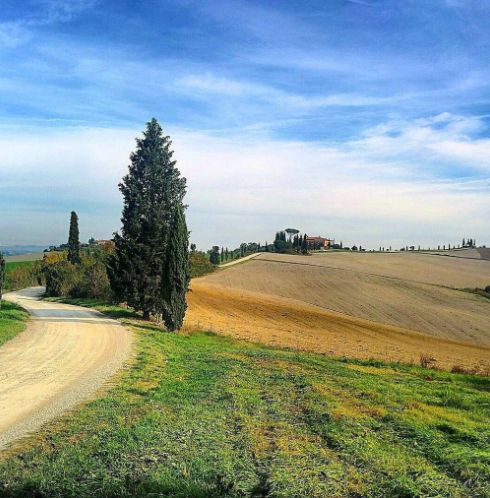by ANGNESE GINTERE
The NEW YORK ITALIAN FOOD & WINE GUY Blog is dedicated to many things, but mainly to three very GREAT ONES being NEW YORK, ITALIAN FOOD, and ITALIAN WINE. What's greater than these?
Wednesday, April 3, 2024
Barolo vs. Barbaresco
Tuesday, March 14, 2023
Love the Pio Cesare BAROLO 2018 Piedmonte
Thursday, September 8, 2022
Villa Calcinaia - Chianti Classico
GREVE in CHIANTI
Villa Calcinaia was once a Florentine outpost on the medieval road of Greve.
It was quite an especially unique treat, eating the private artisnal Capponi Family Salumi while sipping their superb Chianti in the medieval kitchen as the house cook was grilling veal in the ancient fireplace, the veal that would be the main-course of our glorious lunch.
Nicolo then took us through the labyrinth of the Calcinaia Cellars and into a room where the Capponi's have a 300 year old mother. Yes that's right, a "300 Year Old Mother."
Nicolo then led us into the adjacent room and proclaimed, "These are from Ali Baba."
The Count (Conti) then led the way to the fermentation room where the pressed Sangiovese grapes make the estates fine Chianti, as well as their amazing Vino Santo made from Trebbiano of Calcinaaia.
From the fermentation room we went into the cellars where Chianti was being aged in large Slovenian Oak Cask. We took barrel samples out of the 1994 Chianti Reserva and the Chianti Classico 1995 as well. And yes, they were quite tasty to say the least.
Saturday, October 23, 2021
Chianti
There are eight Chianti zones in Tuscany. The biggest, oldest, and the one that may produce the best wine is the Chianti Classico zone. It is called Classico because of it is the oldest zone of the region and it is in the center of the region. The Chianti Classico zone, a very large area between Florence and Siena, includes all the territories of the communes of Castellina in Chianti, Gaiole, Greve, and Radda in Chianti and parts of Barberino Val d'Elsa, Castlenuovo Berardegna, Poggibonsi, San Casciano Val di Pesa and Tavarnelle Val di Pesa.
In 1924, 33 producers get together in Radda in Chianti and founded a consortium to defend and promote Chianti Classico wine and its symbol of origin, the black rooster.
This symbol has always appeared on the bottles of Chianti Classico produced by consortium members. Not all of the producers of Chianti Classico belonged to the consortium and only members were able to use the black rooster on their bottles. In 2005, however, the black rooster became the emblem of the entire Chianti Classical zone.
The Chianti Classico Consortium had the words Gallo Nero printed over the head of the rooster on the neck label of all of its bottles. A few years ago the Gallo winery in California sued the Consortium and won the case. The words were removed from the label.
The black rooster symbol has origins in both the history and legends of Chianti. It was depicted in a painting by Giorgio Vasari on the ceiling of the Salone del Cinquecento in the Palazzo Vecchio in Florence to indicate the military league of Chianti. There is also the legend of the Black Rooster. Florence and Siena in the Middle Ages were always fighting each another over land. The leaders of the rival cities decided to have a horse race to determine the boundary lines. A rider would depart from the capital of each republic and the border would be drawn at the point where the horsemen met. They would set out at dawn by the crowing of a rooster. Siena picked a white rooster and Florence a black rooster. The night before, the black rooster was not fed. It awoke early and the Florentine rider almost reached the gates of Siena before encountering the other rider. The rest is history.
Baron Bettino Ricasoli in the middle of 19 century devised the formula for making Chianti Classico: Sangiovese with such native varieties as Canaiolo and Colorino. Two white grapes had to be included, Trebbiano and Malvasia. It could not be 100% Sangiovese. Many producers back then used the governo method. Ten percent of the grapes (Canaiolo) were dried and then added to the wine. I believe that there is only one producer today, Querciavalle, that still uses this method.
Over the years the percentages and the grapes have changed. Currently, the percentage of Sangiovese is 80% to 100%. Native varieties such as Canaioio and Colorino or foreign ones including Cabernet Sauvignon and Merlot can be added up to 20%. As of the 2006 vintage, the white grapes are no longer allowed.
Chianti Classico can be aged in wood, steel tanks or glass lined cement tanks; the normale is aged for one year before it is released. The riserva must be aged at least two years and an additional three months in bottle and have an alcohol content of at least 12.5% before it can be released. The riserva is a wine that can age for a number of years. The riserva had a gold circle around the black rooster but that stopped in 2005.
"I LOVE CHIANTI" !!!
Monday, August 10, 2020
Chianti Brunello Italian Wine

TUSCAN COUNTRYSIDE
Just Beautiful
A Scene in TUSCANY

Toscano
Tuscany

Girasole
A FIELD of SUNFLOWERS in TUSCANY
The RAGU BOLOGNESE COOKBOOK
DANNY BOLOGNESE
A Bridge
Tuscan CountrySide
Vines of Castel Verrazano
Greve in Chianti
A CAT & CHIANTI
Castello Verrazzano
Greve, ITALY

Italian Cookbook Author Daniel Bellino "Z"
with good friend CAVELIERE LUIGI CAPPELLINI
the owner of CASTELLO VERRAZZANO
Greve ITALY

The CELLARS
CASTELLO VERRAZZANO
"There's a lot of Tasty CHIANTI in those BARRELS" !!!

Large Slovenian Oak Cask in the Cellars of CASTELLO VERRAZZANO
My Favorite BRUNELLO of ALL
BRUNELLO Di MONTALCINO FATTORIA Dei BARBI
In the Cellars of FATTERIA Dei BARBI
"Drink some Brunello" !!!
SUNDAY SAUCE
When Italian-Americans Cook
Daniel Bellino-Zwicke
The ITALIAN NATIONAL FOOTBALL TEAM
.
.
































